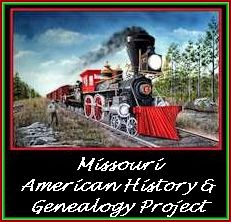 |
History An AHGP Website |
 |
 |
History An AHGP Website |
 |
|
*Adair County, Missouri, in the northern part of the State, is bounded north by
Putnam and Schuyler Counties, east by Scotland and Knox, south by Macon,
and west by Sullivan County, and contains 356,420 acres.
History A settlement, known to the older portions of Howard and Randolph Counties as the
"Cabins of White Folks," was made near the present site of Kirksville in 1828.
The little colony had been established about a year, when they were visited by
a considerable body of the Iowa Indians, who insulted the women and committed
many depredations. The pioneers becoming alarmed, dispatched a messenger to
Randolph County for aid. The messenger reached the house of Wm. Blackwell on
the night of July 24th, 1829, and before many hours the news of the threatened
attack had spread through the settlement, and by the next evening a company
under command of Mr. Trammel, marched to "Grand Narrows," now in Macon County,
so called from a peculiar opening in the timber bordering the prairie. Here
they encamped for the night, and the next day marched to the "Cabins," a
distance of 44 miles. At a council on the morning of the 27th, they determined
to order the Indians to leave. They marched ten miles, and formed a line in the
rear of the Indian encampment and called for an interpreter. As the Indians
appeared, a Mr. Myers, who lived at the "Cabins," recognized an Indian who had
grossly insulted his wife, and immediately shot him dead. The Indians commenced
loading, the squaws with a characteristic whoop retreated, and Capt. Trammel
gave the order to fire. Fifteen guns were discharged and the remainder of the
company broke and ran, the Indians pursuing for a short distance. Three of the
whites were killed and several wounded, Capt. Trammel among others. They
returned to the "Cabins" for the women and children, and, taking up their line
of march southward, traveled all night, never halting until within 5 miles of
Huntsville. The women and children were then sent on to Howard. Richardson,
Guess, Myers, Gross and Blackwell, with about 60 others, under command of Capt.
Sconce, returned to the battle field and buried the bodies of Winn, Owenby and
Myers, who had been killed in the fight. Three Indians were left lying where
they fell. The company returned to Howard where a regiment was organized under
the command of Col. John B. Clark, which speedily drove the Indians north of
the State boundary. This comparatively small affair was one of the incidents
leading to the Black Hawk War.
Physical Features The Chariton River passes through the county from north to south, three to five
miles west of the center, heavy timber extending on either side for several
miles. It's principal tributaries on the west are Blackbird, Shuteye, Spring,
Billey, Hog and Walnut Creeks, and on the east, Hazel, Rye, Big and Sugar Creeks.
In the eastern part of the county are found South Fabius, Cottonwood and Salt
Rivers, Floyd, Steer, Timber, Bear and Bee Creeks, all of which flow in a
south-easterly direction toward the Mississippi. These streams in all their
windings are beautifully fringed with timber, consisting principally of maple,
walnut, hickory, oak, elm, linn and cottonwood. Between the rivers are rich
rolling prairies, which occupy about one-half of the county. The timber land is
fully as productive as the prairie.
Agricultural Productions The soil is mostly fertile and adapted to the raising of nearly all the cereals--
wheat, corn, oats, rye, barley, etc. Tobacco and other crops are also grown with
profit. In grazing facilities it is hardly surpassed by any county in North
Missouri, and is second to none in the North-east. Apples, peaches, pears,
cherries, plums, etc. are grown in abundance. Hay is one of the staple crops,
and timothy seed is receiving increased attention, as farmers are beginning to
realize that it, together with hay, is a profitable crop.
Mineral Resources There is an abundance of coal in the county, also some excellent quarries of
limestone and sandstone.
Manufacturing Manufacturing interests will be noticed under the heads of the various towns
where they are located.
Wealth Valuation of the county per census of 1870, $10,202,000.
Railroads There are two railroads in the county. The St. Louis, Kansas City & Northern
Railway, crossing it from north to south and having 24 1/2 miles of track, and
the Quincy, Missouri & Pacific Railroad, having I3 1/2 miles of track in the
county, thus furnishing Adair a southern, eastern and northern outlet to market.
Exports Exports as yet, are confined to agricultural products and stock. Large quantities
of grain, baled hay, timothy seed, cattle, hogs, etc., are annually shipped
from the several railroad stations in the county.
Educational Interests There are 76 public school houses in the county, with a registered attendance of
4,957 pupils. In addition to these school houses, there are other buildings used
in that capacity in order to furnish room for those attending the schools;
especially is this the case in Kirksville, where the school building, containing
four large rooms, is not sufficient to accommodate all. The North Missouri State
Normal School will be noticed under the head of Kirksville.
*Source: Campbell's Gazatteer of Missouri, Revised Edition, St. Louis: R. A. Campbell, Publisher, 1875.
Do you have documents, photos, or other information for this county? If you are willing to share your information or expertise with other researchers via this site please send us an Email or fill out our Contact Form.
Copyright © 2011~2024 by Missouri AHGP |